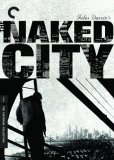| Reviews & Columns |
|
Reviews DVD TV on DVD Blu-ray 4K UHD International DVDs In Theaters Reviews by Studio Video Games Features Collector Series DVDs Easter Egg Database Interviews DVD Talk Radio Feature Articles Columns Anime Talk DVD Savant Horror DVDs The M.O.D. Squad Art House HD Talk Silent DVD
|
DVD Talk Forum |
|
|
| Resources |
|
DVD Price Search Customer Service #'s RCE Info Links |
|
Columns
|
|
|
Naked City - Criterion Collection, The
THE MOVIE:
"While you're thinkin' up a nice story about what didn't happen, supposin' you tell us what did."
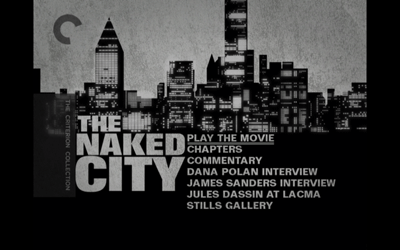
Though the 1948 film version of The Naked City is regularly listed on the classic rosters of film noir, in many ways, I would argue for it being almost an anti-noir, Jules Dassin's clean-up on aisle hardboiled. While notably trading the impressionistic shadows that were a hallmark of the genre with the documentary look of Neorealism (swapping, in effect, the Germans for the Italians), he also extracts the dark cynicism from the crime picture, creating instead a police procedural where the good guys are clearly defined and the bad guys unambiguously punished. Though Dassin still had a few noirish tricks up his sleeve (Night & the City and Rififi were yet to come), he practically invented a whole other animal with The Naked City, eventually spawning the television show of the same name and paving the way for other day-in-the-life cop shows like Dragnet and the contemporary Law & Order franchise, as well as films like Mervyn LeRoy's The FBI Story.
The concept seems ridiculously simple now. Shoot on the streets of New York, in real locations, and follow the investigation of one crime from the discovery of the body through to the apprehension of the murderers. The lead officers establish the unshakable paradigm of the seasoned veteran and the well-meaning rookie: the wonderfully nonchalant Det. Lt. Muldoon (Barry Fitzgerald, The Quiet Man) and the do-gooder family man Jimmy Halloran (Don Taylor, The Flying Leathernecks). Though these two men will essentially be our guides through the complicated case, the camera will actually drift from them to follow the cops on the street tailing suspects, the crime labs going over the evidence, and, in a true stroke of genius, the citizens of the city itself.
Even though The Naked City takes place over several days, Dassin and his screenwriters (Albert Maltz and Malvin Wald) framed the story like it was one day, opening the picture as the sun is setting and night life is entering into full swing. Led by a lively narrator (Mark Hellinger, the movie's producer, speaking as himself), the camera visits people on the night shift and in swank society parties, eavesdropping on the thoughts that drive their evening out or that keep them company as they slog through their tasks. We also see two seemingly random and unconnected crimes, but from a distance, so that we only know what happened but not to who or by whom. On into the next day, as we travel to work with Halloran and listen in on conversations on the subway, New York itself remains a breathing, pulsing element of the story. Often, Dassin's footage is just of crowd scenes, probably shot on the fly, and he would dub in conversations later, layering the dialogue over the image even when the extras weren't talking. While I am sure this was an economical decision, it actually works as an artistic one, adding to the overall feeling that all life in New York is connected. It doesn't matter who is talking, the metropolis is engaged in one ongoing discourse. (The way Dassin weaved through his crowds, jumping from one person to the next, I couldn't help thinking of Wim Wenders' eavesdropping angels in Wings of Desire.)
Some of the plot business in The Naked City comes off as a little dry, but the story is of such a classic model, it's always going to work on some level. As the police officers check out the angles on each clue, they end up finding more clues, gathering details until the various disparate pieces move together and make a complete report of what happened. Some of the work is tedious, hopping from one pawn shop to the next, from one textile merchant to another, but Dassin also takes us on rooftops to talk to construction workers and into tiny, ramshackle diners in search of witnesses. Where the movie starts to hum, however, is in the interrogation room. Muldoon sees right through the lying con man Frank Niles (Howard Duff, All My Sons) and pities his naïve fiancée Ruth (Dorothy Hart, I Was a Communist for the FBI) , and the old detective plays both of them like his own personal marionettes, letting them tell their lies and then tripping them up with the things they don't know he knows. Barry Fitzgerald is the prototypical police trickster, acting as if he's not too with it or maybe even doesn't care, lulling his targets into underestimating him so that he can strike when they least expect it. It's the most flashy element of a movie that otherwise takes some of the glamour out of police work.
Don Taylor is a good foil for Fitzgerald. Looking like a 1940s Luke Wilson, he rushes around digging for information, eager to make it all fit and haul the bad guys in. He's a little bit stiff and a whole lot milquetoast, but he stands as the model of good next to the characters he's bringing to justice. As Niles, Howard Duff is nervous and twitchy while Taylor is confident and solid; where the killer (Ted de Korsia, The Lady from Shanghai) is selfish and dirty, the detective gives of himself and always fights clean.
In the end, though, as the sun goes down on The Naked City yet again, it's driven home that the true story is of the place itself, of the bustling lives that move through the streets and the push and pull between those that break from the social contract and the men who put them back in line. In style, structure, and technique, The Naked City must have seemed revolutionary in 1948. Television has made the movie seem a little old hat by endlessly recycling the formula Dassin and the writers created, but The Naked City will always remain an icon. No one can ever forget the famous last lines from Hallinger's narration: "There are eight million stories in the Naked City...and this was one of them."
Or more accurately, The Naked City was the first, and when it comes down to it, probably still the best--whether it's one of eight hundred, eight million, or even eight billion.
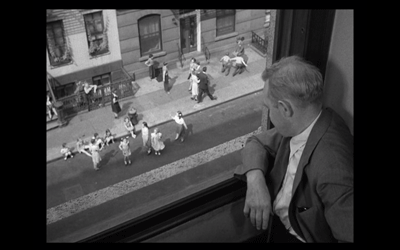
THE DVD
Video:
The Naked City has been on DVD before, but it's been long out of print and the quality of that 1999 release left something to be desired. This new Criterion edition has restored the movie with a new digital transfer at its full-screen 1.33:1 aspect ratio. The back-and-white camera work is rich and detailed, and Dassin's photography of New York is seen here with a remarkable clarity. For the nitpickers, there are still some imperfections, such as stutters where the reels would have changed and sometimes a line or two ingrained in the picture, but I wouldn't worry about it too much.
Sound:
Criterion sticks to a mono mix that is nicely done. Very clean, with excellent values on all the voices and background sounds.
Extras:
There are quite a few extras on The Naked City – Criterion Collection. The most substantial feature is the contemporary audio commentary (recorded in the mid-1990s) by the principle architect of the movie, the original screenwriter Malvin Wald. He is detailed and informative, placing his movie in the proper historical context while also letting us in on the process of inspiration that led to this new idea, including drawing from such creative influences as police reports for an actual unsolved murder, author John Dos Passos, crime photographer Weegee (the original source of the title), westerns, documentaries, and Henry Hathwaway's film The House on 92nd Street. Wald has a good memory of the collaborative process on this movie, as well as the stir The Naked City caused upon release. He also has a modern outlook that encompasses all the various films and TV shows The Naked City has informed. My only complaint with the commentary is that Wald's throat frequently dries out, and listening to his scratchy voice often made my throat hurt.
Two video interviews with scholars emphasize the critical importance of The Naked City. The first is with Dana Polan, a film studies professor and author, and he explains the social tableau of the film in a half-hour lecture illustrated with clips. He puts particular emphasis on the role of immigrants and the class structure as represented in the story, including how this contributed to the HUAAC blacklisting of Dassin and Maltz. He also discusses Dassin's previous film, Brute Force, in essence giving us a sneak peak at the next Dassin movie scheduled to come from Criterion.
The second interviewee is James Sanders, a writer, architect, and Ken Burns' collaborator on the documentary series New York. In the twenty-six minute feature, he goes over the actual locations that show up in the final cut of The Naked City, comparing it to previous Hollywood back-lot recreations of New York and covering what the movies of the Italian Neorealists lent to the look of this picture. He also takes the discussion further into later images of New York in the cinema of the 1970s.
Both interviews are extremely informative and expand how we, as viewers, might interact with the material.
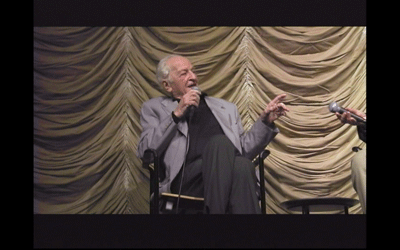
The last video feature is footage from Jules Dassin's 2004 appeared at the Los Angeles County Museum of Art (40 minutes). There is an acknowledged inconsistency of audio quality in the program; it was shot in a lecture hall with a single camera and a p.a. system. The purpose of the talk is to give an overview of Dassin's long career, including his early beginnings and his French exile. Dassin is an amusing raconteur, and it's worth weathering the echo-laden audio to hear his stories, some of which touch on The Naked City.
Finally, we get a stills gallery featuring on-set shots and promotional items. The box art boasts that the original theatrical trailer was to be included; however, I do not see it anywhere on the DVD.
The interior booklet contains new liner notes by author Luc Sante and correspondence that producer Mark Hellinger wrote to Jules Dassin.
FINAL THOUGHTS:
Outside of some minor stiffness in tone/mood, The Naked City – Criterion Collection is still a crackling police drama told in a vivid, Neorealist style. By using New York as its backdrop, the film opens up beyond the average cops and criminals scenario, giving instead a broader glimpse at the environment in which crime can occur. Barry Fitzgerald gives an excellent performance as the savvy homicide detective, but it's hard not to be upstaged by the crisp images of the metropolis as it goes about its daily business. If you like Law & Order or CSI, I Highly Recommended that you schedule a visit to The Naked City and see where it all came from.
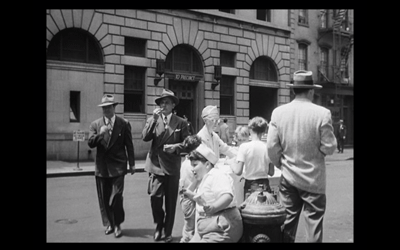
Jamie S. Rich is a novelist and comic book writer. He is best known for his collaborations with Joelle Jones, including the hardboiled crime comic book You Have Killed Me, the challenging romance 12 Reasons Why I Love Her, and the 2007 prose novel Have You Seen the Horizon Lately?, for which Jones did the cover. All three were published by Oni Press. His most recent projects include the futuristic romance A Boy and a Girl with Natalie Nourigat; Archer Coe and the Thousand Natural Shocks, a loopy crime tale drawn by Dan Christensen; and the horror miniseries Madame Frankenstein, a collaboration with Megan Levens. Follow Rich's blog at Confessions123.com.
|
| Popular Reviews |
| Sponsored Links |
|
|
| Sponsored Links |
|
|
| Release List | Reviews | Shop | Newsletter | Forum | DVD Giveaways | Blu-Ray | Advertise |
|
Copyright 2024 DVDTalk.com All Rights Reserved. Legal Info, Privacy Policy, Terms of Use,
Manage Preferences,
Your Privacy Choices | |||||||









